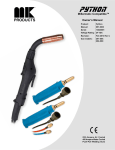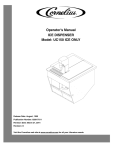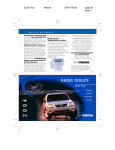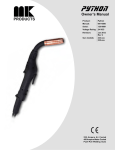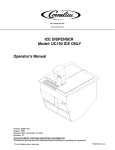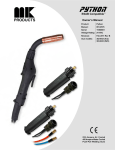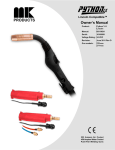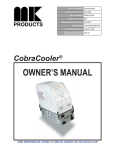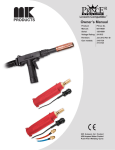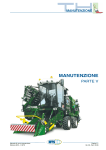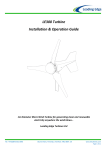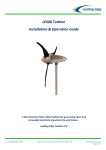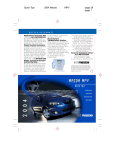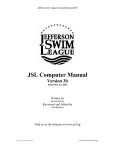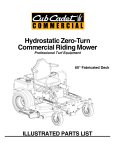Download Owner`s Manual
Transcript
Owner’s Manual Product: CobraTurn Digital Turntable Manual: 091-0677 Serial: 14050001 Voltage Rating: 120 VAC Revision: May 2014 Rev D Model Number: 127-006 n ow Sh h wit tion op ble nta ur al t Table of Contents Safety Considerations.........................................................................i-iii Installation................................................................................ Section A Features..............................................................................................................1 Ground/Gas/Foot Pedal Connection...................................................................1 Technical Specifications......................................................................................2 Dimensions.........................................................................................................3 Operation..................................................................................Section B Operating Procedure...........................................................................................4 Troubleshooting..................................................................................................5 Accessories..............................................................................Section C Kits......................................................................................................................5 Remote Hookups................................................................................................6 Appendices...............................................................................Section F Diagrams / Parts List...........................................................................................7 Mechanical..........................................................................................................8 Electrical........................................................................................................... 11 Safety Warnings Warranty THIS PAGE INTENTIONALLY BLANK SAFETY CONSIDERATIONS ELECTRIC ARC WELDING EQUIPMENT CAUTION : READ BEFORE ATTEMPTING INSTALLATION, OPERATION OR MAINTENANCE OF THIS EQUIPMENT 1-1 INTRODUCTION This equipment is intended for ultimate application by commercial/industrial users and for operation by persons trained and experienced in the use and maintenance of welding equipment. Operation should not be undertaken without adequate training in the use of such equipment. Training is available from many public and private schools or similar facilities. Safe practices in the installation, operation and maintenance of this equipment requires proper training in the art, a careful study of the information provided with the equipment, and the use of common sense. Rules for safe use are generally provided by suppliers of welding power sources, compressed gas suppliers, and electrode suppliers. Careful compliance with these rules will promote safe use of this equipment. The following Safety Rules cover some of the more generally found situations. READ THEM CAREFULLY. In case of any doubt, obtain qualified help before proceeding. 1-2 GENERAL PRECAUTIONS A. Burn Prevention ELECTRIC ARC WELDING PRODUCES HIGH INTENSITY HEAT AND ULTRAVIOLET RADIANT ENERGY WHICH MAY CAUSE SERIOUS AND PERMANENT EYE DAMAGE AND WHICH MAY DAMAGE ANY EXPOSED SKIN AREAS. Wear helmet with safety goggles or glasses with side shields underneath, appropriate filter lenses or plates (protected by clear cover glass). This is a must for welding or cutting (and chipping) to protect the eyes from radiant energy and flying metal. Replace cover glass when broken, pitted, or spattered. Medical first aid and eye treatment. First aid facilities and a qualified first aid person should be available for each shift unless medical facilities are close by for immediate treatment of flash burns of the eyes and skin burns. Wear protective clothing - leather (or asbestos) gauntlet gloves, hat, and high safety-toe shoes. Button shirt collar and pocket flaps, and wear cuffless trousers to avoid entry of sparks and slag. Avoid oily or greasy clothing. A spark may ignite them. Flammable hair preparations should not be used by persons intending to weld or cut. Hot metal such as electrode stubs and work pieces should never be handled without gloves. Ear plugs should be worn when working on overhead or in a confined space. A hard hat should be worn when others work overhead. B. Toxic Fume Prevention WARNING: The use of this product may result in exposure to chemicals known to the State of California to cause cancer and birth defects or other reproductive harm. Adequate ventilation. Severe discomfort, illness or death can result from fumes, vapors, heat, or oxygen enrichment or depletion that welding (or cutting) may produce. Prevent them with adequate ventilation. NEVER ventilate with oxygen. Lead-, cadmium-, zinc-, mercury-, beryllium-bearing and similar materials, when welded or cut, may produce harmful concentrations of toxic fumes. Adequate local exhaust ventilation must be used, or each person in the area, as well as the operator, must wear an air-supplied respirator. For beryllium, both must be used. Metals coated with or containing materials that emit toxic fumes should not be heated unless coating is removed form the work surface, the area is well ventilated, or the operator wears an air-supplied respirator. Work in a confined space only while it is being ventilated and, if necessary, while wearing an air-supplied respirator. Causes of fire and explosion are: combustibles reached by the arc, flame, flying sparks, hot slag, or heated material, misuse of compressed gases and cylinders, and short circuits. BE AWARE THAT flying sparks or falling slag can pass through cracks, along pipes, through windows or doors, and through wall or floor openings, out of sight of the goggled operator. Sparks can fly many feet. To prevent fires and explosion: Keep equipment clean and operable, free of oil, grease, and (in electrical parts) of metallic particles that can cause short circuits. If combustibles are in area, do NOT weld or cut. Move the work if practicable, to an area free of combustibles. Avoid paint spray rooms, dip tanks, storage areas, ventilators. If the work cannot be moved, move combustibles at least 35 feet away, out of reach of sparks and heat; or protect against ignition with suitable and snug-fitting, fire-resistant covers or shields. Walls touching combustibles on opposite sides should not be welded on (or cut). Walls, ceilings, and floor near work should be protected by heat-resistant covers or shields. Fire watcher must be standing by with suitable fire extinguishing equipment during and for some time after welding or cutting if: Gas leaks in a confined space should be avoided. Leaked gas in large quantities can change oxygen concentration dangerously. Do not bring gas cylinders into a confined space. 1. Appreciable combustibles (including building construction) are within 35 feet. Leaving confined space, shut OFF gas supply at source to prevent possible accumulation of gases in the space if downstream valves have been accidentally opened or left open. Check to be sure that the space is safe before reentering it. 3. Openings (concealed or visible) in floors or walls within 35 feet may expose combustibles to sparks. Vapors from chlorinated solvents can be decomposed by the heat of the arc (or flame) to form PHOSGENE, a highly toxic gas, and other lung and eye irritating products. The ultraviolet (radiant) energy of the arc can also decompose trichloroethylene and perchloroethylene vapors to form phosgene. DO NOT WELD or cut where solvent vapors can be drawn into the welding or cutting atmosphere or where the radiant energy can penetrate to atmospheres containing even minute amounts of trichloroethylene or perchloroethylene. C. Fire and Explosion Prevention 2. Appreciable combustibles are further than 35 feet, but can be ignited by sparks. 4. Combustibles adjacent to walls, ceilings, roofs, or metal partitions can be ignited by radiant or conducted heat. Hot work permit should be obtained before operation to ensure supervisor’s approval that adequate precautions have been taken. After work is done, check that area is free of sparks, glowing embers, and flames. An empty container that held combustibles, or that can produce flammable or toxic vapors when heated, must never be welded on or cut, unless container has first been cleaned in accordance with industry standards. This includes: a thorough steam or caustic cleaning (or a solvent of water washing, depending on the combustible’s solubility), followed by purging and inerting with nitrogen or carbon dioxide, and using protective equipment. Water-filling just below working level may substitute for inerting. A container with unknown contents should be cleaned (see paragraph above). Do NOT depend on sense of smell or sight to determine if it is safe to weld or cut. Hollow castings or containers must be vented before welding or cutting. They can explode. Explosive atmospheres. NEVER weld or cut where the air may contain flammable dust, gas, or liquid vapors (such as gasoline). D. Compressed Gas Equipment The safe handling of compressed gas equipment is detailed in numerous industry publications. The following general rules cover many of the most common situations. 1. Pressure Regulators Regulator relief valve is designed to protect only the regulator from overpressure; it is not intended to protect any downstream equipment. Provide such protection with one or more relief devices. Never connect a regulator to a cylinder containing gas other than that for which the regulator was designed. Remove faulty regulator from service immediately for repair (first close cylinder valve). The following symptoms indicate a faulty regulator: Leaks - if gas leaks externally. Excessive Creep - if delivery pressure continues to rise with downstream valve closed. Faulty Gauge - if gauge pointer does not move off stop pin when pressurized, nor returns to stop pin after pressure release. Repair. Do NOT attempt repair. Send faulty regulators for repair to manufacturer’s designated repair center, where special techniques and tools are used by trained personnel. 2. Cylinders Cylinders must be handled carefully to prevent leaks and damage to their walls, valves, or safety devices: Avoid electrical circuit contact with cylinders including third rails, electrical wires, or welding circuits. They can produced short circuit arcs that may lead to a serious accident. (See 1-3C) ICC or DOT marking must be on each cylinder. It is an assurance of safety when the cylinder is properly handled. Identifying gas content. Use only cylinders with name of gas marked on them; do not rely on color to identify gas content. Notify supplier if unmarked. NEVER DEFACE or alter name, number, or other markings on a cylinder. It is illegal and hazardous. Empties: Keep valves closed, replace caps securely; mark MT; keep them separate from FULLS, and return promptly. Prohibited use. Never use a cylinder or its contents for other than its intended use, NEVER as a support or roller. Locate or secure cylinders so they cannot be knocked over. Passageways and work areas. Keep cylinders clear of areas where they may be stuck. Transporting cylinders. With a crane, use a secure support such as a platform or cradle. Do NOT lift cylinders off the ground by their valves or caps, or by chains, slings, or magnets. Do NOT expose cylinders to excessive heat, sparks, slag, and flame, etc. that may cause rupture. Do not allow contents to exceed 55 degrees C (130 degrees F.) Cool with water spray where such exposure exists. Protect cylinders, particularly valves from bumps, falls, falling objects, and weather. Replace caps securely when moving cylinders. Stuck valve. Do NOT use a hammer or wrench to open a cylinder valve that cannot be opened by hand. Notify your supplier. Mixing gases. NEVER try to mix any gases in a cylinder. NEVER refill any cylinder. Cylinder fittings should never be modified or exchanged. 3. Hose Prohibited use. Never use hose other than that designed for the specified gas. A general hose identification rule is: red for fuel gas, green for oxygen, and black for inert gases. Use ferrules or clamps designed for the hose (not ordinary wire or other substitute) as a binding to connect hoses to fittings. No copper tubing splices. Use only standard brass fittings to splice hose. away from people and sources of ignition. Wipe with a clean, lintless cloth. Match regulator to cylinder. Before connecting, check that the regulator label and cylinder marking agree, and that the regulator inlet and cylinder outlet match. NEVER Connect a regulator designed for a particular gas or gases to a cylinder containing any other gas. Tighten connections. When assembling threaded connections, clean and smooth seats where necessary. Tighten. If connection leaks, disassemble, clean, and retighten, using properly fitting wrench. Adapters. Use a CGA adapter (available from your supplier) between cylinder and regulator, if one is required. Use two wrenches to tighten adapter marked RIGHT and LEFT HAND threads. Regulator outlet (or hose) connections may be identified by right hand threads for oxygen and left hand threads (with grooved hex on nut or shank) for fuel gas. 5. Pressurizing Steps: Drain regulator of residual gas through suitable vent before opening cylinder (or manifold valve) by turning adjusting screw in (clockwise). Draining prevents excessive compression heat at high pressure seat by allowing seat to open on pressurization. Leave adjusting screw engaged slightly on single-stage regulators. Stand to side of regulator while opening cylinder valve. Open cylinder valve slowly so that regulator pressure increases slowly. When gauge is pressurized (gauge reaches regulator maximum) leave cylinder valve in following position: for oxygen and inert gases, open fully to seal stem against possible leak; for fuel gas, open to less than one turn to permit quick emergency shut-off. Use pressure charts (available from your supplier) for safe and efficient recommended pressure settings on regulators. Avoid long runs to prevent kinks and abuse. Suspend hose off ground to keep it from being run over, stepped on, or otherwise damaged. Check for leaks on first pressurization and regularly thereafter. Brush with soap solution. Bubbles indicate leaks. Clean off soapy water after test; dried soap is combustible. Coil excess hose to prevent kinks and tangles. E. User Responsibilities Protect hose from damage by sharp edges, and by sparks, slag, and open flame. Remove leaky or defective equipment from service immediately for repair. Read and follow user manual instructions. Examine hose regularly for leaks, wear, and loose connections. Immerse pressured hose in water; bubbles indicate leaks Repair leaky or worn hose by cutting area out and splicing. Do NOT use tape. 4. Proper Connections Clean cylinder valve outlet of impurities that may clog orifices and damage seats before connecting regulator. Except for hydrogen, crack valve momentarily, pointing outlet Follow all Safety Rules. F. Leaving Equipment Unattended Close gas supply at source and drain gas. G. Rope Staging-Support Rope staging-support should not be used for welding or cutting operation; rope may burn. 1-3 ARC WELDING Comply with precautions in 1-1, 1-2, and this section. Arc Welding, properly done, is a safe process, but a careless operator invites trouble. The equipment carries high currents at significant voltages. The arc is very bright and hot. Sparks fly, fumes rise, ultraviolet and infrared energy radiates, weldments are hot, and compressed gases may be used. The wise operator avoids unnecessary risks and protects himself and others from accidents. A. Burn Protection Comply with precautions in 1-2. The welding arc is intense and visibly bright. Its radiation can damage eyes, penetrate lightweight clothing, reflect from light-colored surfaces, and burn the skin and eyes. Skin burns resemble acute sunburn; those from gas-shielded arcs are more severe and painful. DON’T GET BURNED; COMPLY WITH PRECAUTIONS. 1. Protective Clothing Wear long-sleeve clothing in addition to gloves, hat, and shoes. As necessary, use additional protective clothing such as leather jacket or sleeves, flameproof apron, and fire-resistant leggings. Avoid outer garments of untreated cotton. Bare skin protection. Wear dark, substantial clothing. Button collar to protect chest and neck, and button pockets to prevent entry of sparks. 2. Eye and Head Protection Protect eyes from exposure to arc. Eyes may be damaged by radiant energy when exposed to the electric arc, even when not looking in the direction of the arc. Never look at an electric arc without protection. Welding helmet or shield containing a filter plate shade no. 12 or denser must be used when welding. Place over face before striking arc. Protect filter plate with a clear cover plate. Cracked or broken helmet or shield should NOT be worn; radiation can be passed through to cause burns. Cracked, broken, or loose filter plates must be replaced IMMEDIATELY. Replace clear cover plate when broken, pitted, or spattered. Flash goggles with side shields MUST be worn under the helmet to give some protection to the eyes should the helmet not be lowered over the face before an arc is struck. Looking at an arc momentarily with unprotected eyes (particularly a high intensity gas-shielded arc) can cause a retinal burn that may leave a permanent dark area in the field of vision. 3. Protection of Nearby Personnel Enclose the welding area. For production welding, a separate room or enclosed bay is best. In open areas, surround the operation with low-reflective, noncombustible screens or panels. Allow for free air circulation, particularly at floor level. Viewing the weld. Provide face shields for all persons who will be looking directly at the weld. Others working in area. See that all persons are wearing flash goggles. Before starting to weld, make sure that screen flaps or bay doors are closed. B. Toxic Fume Prevention Comply with precautions in 1-2B. Generator engine exhaust must be vented to the outside air. Carbon monoxide can kill. C. Fire and Explosion Prevention Comply with precautions in 1-2C. Equipment’s rated capacity. Do not overload arc welding equipment. It may overheat cables and cause a fire. Loose cable connections may overheat or flash and cause afire. Never strike an arc on a cylinder or other pressure vessel. It creates a brittle area that can cause a violent rupture or lead to such a rupture later under rough handling. D. Compressed Gas Equipment Comply with precautions in 1-2D. E. Shock Prevention Exposed electrically hot conductors or other bare metal in the welding circuit, or in ungrounded, electrically-HOT ous condition that can shock, possibly fatally. Before welding, check ground for continuity. Be sure conductors are touching bare metal of equipment frames at connections. If a line cord with a ground lead is provided with the equipment for connection to a switch box, connect the ground lead to the grounded switch box. If a three-prong plug is added for connection to a grounded mating receptacle, the ground lead must be connected to the ground prong only. If the line cord comes with a three-prong plug, connect to a grounded mating receptacle. Never remove the ground prong from a plug, or use a plug with a broken ground prong. 2. Connectors Fully insulated lock-type connectors should be used to join welding cable lengths. 3. Cables Frequently inspect cables for wear, cracks, and damage. IMMEDIATELY REPLACE those with excessively worn or damaged insulation to avoid possibly lethal shock from bared cable. Cables with damaged areas may be taped to give resistance equivalent to original cable. Keep cable dry, free of oil and grease, and protected from hot metal and sparks. equipment can fatally shock a person whose body becomes a conductor. DO NOT STAND, SIT, LIE, LEAN ON, OR TOUCH a wet surface when welding without suitable protection. 4. Terminals and Other Exposed Parts Terminals and other exposed parts of electrical units should have insulating covers secured before operation. To protect against shock: 5. Electrode Wire Electrode wire becomes electrically HOT when the power switch of gas metal-arc welding equipment is ON and welding gun trigger is pressed. Keep hands and body clear of wire and other HOT parts. Keep body and clothing dry. Never work in damp area without adequate insulation against electrical shock. Stay on a dry duckboard, or rubber mat when dampness or sweat cannot be avoided. Sweat, sea water, or moisture between body and an electrically HOT part - or grounded metal - reduces the body surface electrical resistance, enabling dangerous and possibly lethal currents to flow through the body. 1. Grounding the Equipment When installing, connect the frames of each unit such as welding power source, control, work table, and water circulator to the building ground. Conductors must be adequate to carry ground currents safely. Equipment made electrically HOT by stray currents may shock, possibly fatally. Do NOT GROUND to electrical conduit, or to a pipe carrying ANY gas or a flammable liquid such as oil or fuel. Three-phase connection. Check phase requirement of equipment before installing. If only three-phase power is available, connect single-phase equipment to only two wires of the three-phase line. Do NOT connect the equipment ground lead to the third (live) wire, or the equipment will become electrically HOT - a danger- 6. Safety Devices Safety devices such as interlocks and circuit breakers should not be disconnected or shunted out. Before installation, inspection, or service of equipment, shut OFF all power, and remove line fuses (or lock or red-tag switches) to prevent accidental turning ON of power. Disconnect all cables from welding power source, and pull all 115 volts line-cord plugs. Do not open power circuit or change polarity while welding. If, in an emergency, it must be disconnected, guard against shock burns or flash from switch arcing. Leaving equipment unattended. Always shut OFF, and disconnect all power to equipment. Power disconnect switch must be available near the welding power source. Thank You For selecting a quality product. We want you to take pride in operating this product...as much pride as we have in bringing the product to you! Please Examine Carton and Equipment For Damage Immediately When this equipment is shipped, title passes to the purchaser upon receipt by the carrier. Consequently, claims for material damaged in shipment must be made by the purchaser against the transportation company at the time the shipment is received. Please record your equipment identification information below for future reference. This information can be found on your machine nameplate. Model Name & Number _____________________ Code & Serial Number _____________________ Date of Purchase _____________________ Whenever you request replacements parts for, or information on this equipment always supply the information you have recorded above. Read this Owner’s Manual completely before attempting to use this equipment. Save this manual and keep it handy for quick reference. Pay particular attention to the safety instructions we have provided for your protection. Section A Installation Features Forward/Reverse (DIR) Push Button On/Off (PWR) Push Button Digital RPM LED Display Tilt Release/ Push Knob Speed Control/LED Brightness Adjustment Knob Start/Stop/Jog Push Button Ground/Gas/Foot Pedal connections Foot Pedal/Remote Connector Ground Lug Gas Connector Fuse in Power Cord P/N 151-0050 Tilt Release/Push Knob CobraTurn™ Digital Turntable Owner's Manual - Page 1 Technical Specifications Model 127-006 Optional Turntable Diameter 10" Degrees Tilt 0° to 90° Speed Range R.P.M. Low .3 High 10 Ground Capacity AMPS Input Voltage 400A 60% Duty Cycle 120VAC 50/60 Hz Shipping Transmission Weight 32 lbs Gear Load Specifications Turntable Vertical • 300 lbs. in the vertical position from 1-4 RPM with a balanced & centered load, 5” max from the table surface • 150 lbs. in the vertical position from 0.3-10 RPM with a balanced & centered load, 7” max from table surface Turntable Horizontal • 300 lbs. in the horizontal position from 0.3-10 RPM with a balanced load & centered load CobraTurn™ Digital Turntable Owner's Manual - Page 2 Dimensions CobraTurn™ Digital Turntable Owner's Manual - Page 3 Section B Operation Operating Procedure 1. Connect turntable to 120 VAC power source. 2. Connect welding ground cable to grounding lug assembly on turntable. NOTE: Failure to attach a welding ground cable to the CobraTurn™ Digital Turntable grounding lug will result in damage to the turntable electrical circuit and void unit's warranty. 3. Connect foot switch/pedal if required, "PdL" will be briefly displayed (see picture on page 1). PWR Button 4. Push PWR button to switch the unit on. NOTE: If unit doesn't turn on, check power connection and the fuse. 5. The display will briefly show the firmware version and then show the last rotational speed used. If you see any other message, please see the Troubleshooting section. DIR Button 6. To adjust display and indicators' brightness press and hold DIR button (the turntable must be stopped). After ~1 sec., the display changes and shows the brightness value (1 to 63), rotate knob to adjust brightness of the display. Release DIR button when done. 7. Push DIR push button to desired rotation direction. 8. Establish desired speed setting using the knob while reading the LED display on the turntable. Knob Button 9. To start turntable with the set speed press knob and release within 1 sec., the motor will start and the knob lights green. Press knob again to stop and the knob flashes red then turns blue. If the knob is held longer than 1 sec., the turntable starts jogging (10 RPM), knob lights blinking green and turntable jogs until released. NOTE: When knob is pressed, the knob rotation is ignored to prevent value changes while pressing. With the foot pedal plugged in, the speed setting displayed is the maximum speed the foot pedal will use. While pressing the foot pedal, the display shows speed of the foot pedal setting. NOTE: When the foot pedal is plugged in, the Start/Stop function of the knob is disabled. 10.Press and hold the PWR button (display shows “OFF”) until power is turned to standby mode. If released sooner, the display returns to normal. NOTE: The unit is not completely off unless it is unplugged from power source. NOTE: Pressing invalid key causes "Err" message displayed for ~2 sec. NOTE: Pressing invalid key while foot pedal is plugged in, displays "PdL" and key is ignored. NOTE: All turntable settings and calibration are preserved when power is turned off. CobraTurn™ Digital Turntable Owner's Manual - Page 4 Additional Display Messages • nEE: This means the turntable memory was not set or lost. Power cord needs to be unplugged to reset. If this error persists, please contact MK support. • bAd: This message is displayed for about 3 seconds and default settings are restored and self-testing continues. WARNING: The turntable SHOULD be recalibrated. • CAL: If the display shows "CAL", the hardware calibration needs to be performed (never calibrated or corrupted). NOTE: Calibration requires special setup. Contact MK Products for details. Section C Accessories Kits 005-0040 3-Jaw Chuck (optional) 005-0677 10" Turntable (optional) 005-0747 On/Off Foot Switch (standard) 005-0746 Heavy Duty Variable Speed Foot Control (optional) CobraTurn™ Digital Turntable Owner's Manual - Page 5 Remote Hookups This section explains how to interface external controls to the CobraTurn™ Digital Turntable including the standard Foot Switch and Variable Speed Foot Control available from MK Products. The Trigger and Jog inputs may be Switches or Signals Levels. (low=0v high= 3.3V) CobraTurn™ Digital Turntable Owner's Manual - Page 6 Appendices Diagrams / Parts List Turntable Assembly..................................................................... 8 Housing Assembly..................................................................... 10 Electrical.................................................................................... 11 CobraTurn™ Digital Turntable Owner's Manual - Page 7 CobraTurn Digital Turntable Assembly CobraTurn™ Digital Turntable Owner's Manual - Page 8 CobraTurn™ Digital Turntable Owner's Manual - Page 9 1 2 3 4 5 6 7 8 9 10 11 12 13 14 15 16 17 18 19 1 1 1 1 1 1 1 1 1 1 1 2 1 2 1 10 2 1 4 No. Qty. 003-2498 003-2499 003-2500 003-2501 003-2504 005-0777 145-0041 153-0909 261-0167 303-0110 309-0006 313-0013 313-0136 315-0030 319-0022 320-0095 320-0127 321-1111 328-0047 Part No. ASSY BASE TURNTABLE ASSY MOTOR TURNTABLE ASSY HOUSING TURNTABLE ASSY FRONT PNL ELEC BOX TURNTABLE ASSY KNOB TURNTABLE ASSY PCB FR PNL CNTLR TURNTABLE BEZEL SNAP-IN BLACK CON HSG CRMP 3T .156 .04 SLEEVE HANDLE TURNTABLE ORING 13/16 ID x 15/16 OD GASKET RUBBER E-RING 3/4ID RING EXT 13/16" ID BRG SLV THRUST 3/4ID X 1-1/4OD X 1/16LG SCR FHSC 10-24X1/2 ST BLK OXIDE SCR BHSC 8-32X1/4 ST BLK ZINC SCR BHSC 10-24X1/2 ST BLK ZINC SSCR CONE 1/4-20X3/8 SS SCR SHC 10-32 X 5/8 Description 20 21 22 23 24 25 26 27 28 29 30 31 32 33 34 35 36 37 38 1 4 1 6 3 1 4 1 2 1 1 1 1 1 1 1 A/R A/R 1 Front Body Assembly 331-0119 333-0007 333-0041 333-0044 336-0105 336-0108 336-0130 351-0266 405-1363 419-0130 431-2055 431-2060 431-2064 431-2065 431-2072 438-0088 823-0050 835-0018 843-0712 WSHR SS .540 ID x .75 OD x .02 THK WSHR SPR LK #10 WSHR LK #4 INTL STAR STL WSHR LK #8 INTL STAR STL SCR PN P 4-40X3/16 SS SCR PN P 4-40X3/8 SS SCR PN P 8-32X3/8 SS STRAIN RELIEF 90 DEG LABEL TURNTABLE SPR COMP WASHER TURNTABLE HANDLE TURNTABLE SHAFT AXLE TURNTABLE KNOB PUSH TURNTABLE PLUNGER LOCK TURNTABLE PAINT PANEL BACK TURNTABLE LOCTITE 222 PURPLE GREASE RENOLT G193 ASSY POWER CABLE CobraTurn Digital Turntable Housing Assembly APPLY ADH LOCTITE 222 PURPLE - LOW STR APPLY COMPOUND JOINT NOALOX APPLY O-RING SILICONE LUBRICANT APPLY GREASE RENOLIT G193 APPLY LOCTITE, PST PIPE SEALANT APPLY O-RING SILICONE LUBRICANT No. Qty 1 2 3 4 5 6 7 8 9 10 11 12 13 14 15 16 17 18 19 20 1 1 2 1 2 1 1 1 1 Housing Turntable Assembly Part 003-2503 316-0026 331-0188 333-0013 341-0106 431-2039 431-2057 431-2061 716-0009 Description ASSY GROUND CABLE Not available separately Not available separately Not available separately Not available separately SCR TR P 8-32X1/4 SST WSHR FL 0.525ID X 0.875ODX0.063T Brass WSHR SPR LK #1/2 NUT HX 1/2-13UNC 5/16THK BRS Not available separately Not available separately Not available separately GAS FITTING RIGHT ANGLE WASHER INSUL GROUND COPPER BRUSH TURNTABLE Not available separately Not available separately Not available separately Not available separately DISC WIRE CLOTH SS 0.5 OD CobraTurn™ Digital Turntable Owner's Manual - Page 10 CobraTurn Digital Turntable Electrical CobraTurn™ Digital Turntable Owner's Manual - Page 11 16882 Armstrong Ave. Irvine, CA 92606 Tel (949)863-1234 Fax (949)474-1428 www.mkproducts.com August 1, 2010 THIS PAGE INTENTIONALLY BLANK 16882 Armstrong Ave. Irvine, CA 92606 Tel (949)863-1234 Fax (949)474-1428 www.mkproducts.com
























